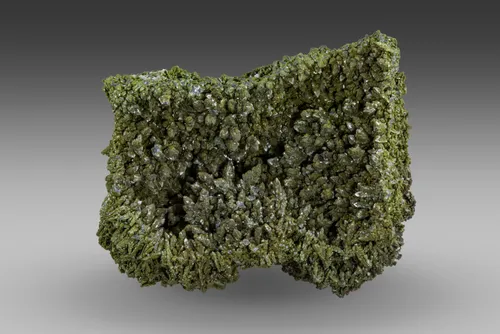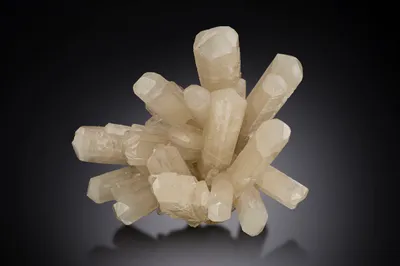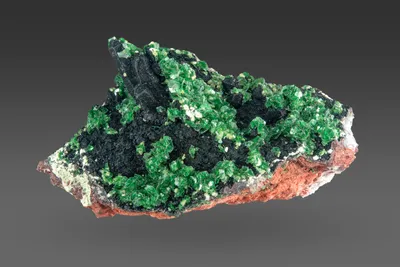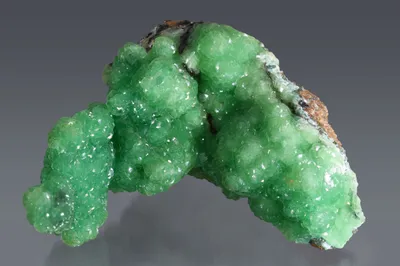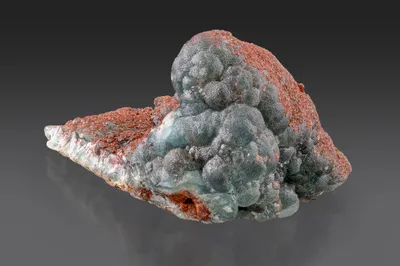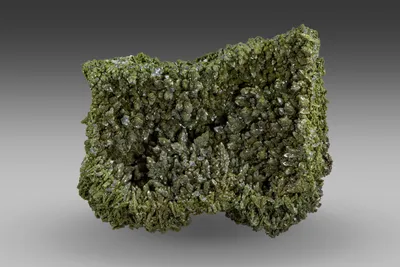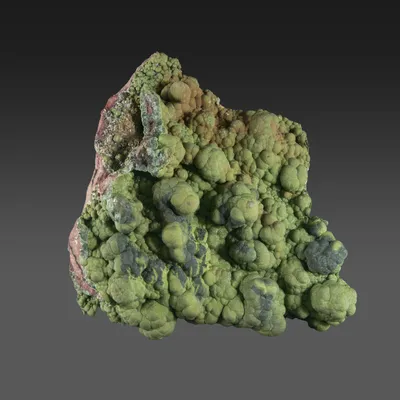
Mineral Species
Mottramite
Type Locality
No
Composition
PbCuVO4(OH)
Crystal System
Orthorhombic
Status at Tsumeb
Confirmed
Abundance
Common
Distribution
First, second and third oxidation zones
Paragenesis
Supergene
Entry Number
Species; TSNB249
General Notes
Mottramite is a common mineral at Tsumeb, particularly in the upper portions of the first and second oxidation zones. It occurs typically as radially structured masses, often dendritic or arborescent and usually porous, or as dendritic or moss-like coatings. Idiomorphic crystals of mottramite (with an acicular habit) are very rare and do not exceed a few mm in length (Keller 1984).
Maucher (1908a) described "… blackish olive-green crusts" of mottramite the identification of which he confirmed by blowpipe analysis.
Klein (1938) noted that mottramite is by far the most important vanadium-bearing mineral at Tsumeb and commented that vanadium minerals were of economic significance to a depth of 85 m (3 Level) and present in minor quantities to a depth of 160 m (6 level). He also noted a tendency for mottramite to occur in marginal parts of the ore body as crusts, coatings and infillings in solution cavities.
Bartelke (1976) observed mottramite with a relatively wide range of associated minerals in the upper levels of the mine, but with a tendency to occur alone or simply with calcite or cerussite in the second oxidation zone. He noted crusts of mottramite to several centimetres thick.
Pinch and Wilson (1977) commented that mottramite "Forms yellow-green to dark greenish-brown masses and arborescent botryoidal groups. It is widely disseminated at Tsumeb but rarely forms attractive specimens".
Lombaard et al. (1986) stated that high concentrations of vanadium (principally as mottramite) persisted from surface to 4 Level (i.e., the upper portion of the first oxidation zone. They noted a similar concentration of vanadium, again principally as mottramite, in the upper portion of the second oxidation zone.
Former TCL geologist Clive King recalls that in circa 1983, he and TCL mineralogist John Innes collected "…fine botryoidal dark olive-green mottramite specimens from the Grȫsse-Uberschiebṻng shear zone that was intersected in the decline ramp between 2 and 3 levels" (Clive King, pers. comm. to M. Southwood, June 2025).
Gebhard (1999) noted that "ball-like clusters" of mottramite to several kilograms were common.
Pufahl (1920) published separate analyses for mottramite and for cuprodescloizite from Tsumeb, although both analyses show compositions that would now be regarded as mottramite. A modern recalculation of empirical formulae from Pufahl's analyses (basis 4.5 oxygens) gives Pb1.06(Cu0.96Zn0.01)(V0.95As0.04)(OH) for his mottramite specimen and Pb0.99(Cu0.82Zn0.17)(V0.96As0.04)(OH) for his cuprodescloizite (which can reasonably be termed a Zn-bearing mottramite).
Bannister and Hey (1933) published analyses of mottramite and descloizite from several worldwide localities and found that their mottramite from Tsumeb contained only 2.62 wt % Zn (corresponding to 0.13 APFU). Some thirty years later Von Rahden and Dicks (1967) failed to detect zinc in a specimen of near end-member mottramite from Tsumeb.
Darker coloured examples of mottramite of certain habits, however, have commonly been mistaken for descloizite (with which mottramite forms a series). A recent quantitative EMPA study of ten mottramite specimens selected to cover as wide a range of colour as possible, showed mean zinc contents ranging from 0.00 APFU (end-member mottramite) to 0.37 APFU (a Zn-rich mottramite), but none of the 101 analyses showed zinc content > 0.50 APFU that would indicate descloizite (M. Southwood and P. Carr, University of Wollongong, unpublished data).
Keller (1977a) cautioned that mottramite is readily confused with other minerals such as arsentsumebite, bayldonite, conichalcite and duftite. His study of second oxidation zone parageneses agreed with Bartelke’s (1976) observation that mottramite tends to occur as moss-like coatings on calcite or as porous monomineralic masses accompanied by few (if any) other secondary minerals. Nevertheless, he observed mottramite in association with 13 other minerals, of which he considered calcite to be the most common associate, followed by azurite, dolomite, duftite, goethite and olivenite, with arsentsumebite, brochantite, cerussite, quartz, rosasite, smithsonite and willemite as less common or rare associates.
Keller (1977a) included mottramite in one of his "Type I" parageneses (i.e., minerals formed under relatively higher pH conditions):
I/8: quartz >> mottramite >> olivenite(i & ii) >> duftite >> malachite >> azurite >> malachite (ps. azurite)
Associated Minerals
anglesite; aragonite; arsentsumebite; azurite; bayldonite; bornite; brochantite; calcite; cerussite; chalcophanite; coronadite; descloizite; dioptase; dolomite; duftite; goethite; malachite; mimetite; minium; olivenite; pyrolusite; quartz; romanèchite (?); rosasite; smithsonite; tangeite (?); tennantite-(Zn); vanadinite; vésigniéite (?); willemite; wulfenite
